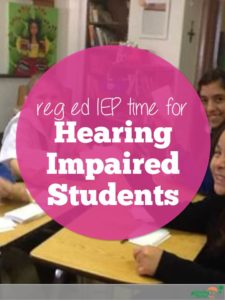Please welcome my guest blogger, Monica Faherty, CCC-SLP!
Why have regular education service delivery time on an IEP for hearing impaired students?
Speech-language pathologists, audiologists and regular education teachers now have more chances than ever before of encountering a hearing impaired student due to the success of early identification and intervention programs and high quality technology in hearing aids and cochlear implants.
For these students to be successful educationally, the best results are obtained when they are supported by a team.
This team is typically composed of the parents, audiologist, teacher of deaf/hard of hearing (TOD), regular education teachers, and speech-language pathologist (SLP). Communication among team members is important and I find it works best when one of these professionals takes the lead in collaborating, coordinating and informing everyone. Usually this is the TOD or SLP.
If a student’s language skills are age-appropriate or close to it, all or most of the student’s day will be in the regular class. It is essential that the audiologist, TOD and/or SLP monitor the student in that setting to help gather data for evaluations, IEPs or progress reports.
As the TOD I take that role of proposing regular classroom service delivery along with special education service delivery on IEPs. It looks like this:
This allows me to see how well the student is applying what we’ve been working on and if there are any issues that need to be problem-solved with the rest of the team. Regular education teachers frequently ask me why I want to be in their rooms. Giving them specific examples of what I’m looking for usually paves the way for my involvement. I’m checking to see:
- Is there a noisy peer sitting close to the student? If so how does my student handle the situation? This gives me information for our next pullout session. Does the student need coaching on how to handle the situation? If so, I provide that, we role-play and discuss.
- Does the student need accommodations that are not already on the IEP?
- Is the student using current accommodations? If not, why?
- Does the student need to let the teacher know about an issue? If so, we discuss that in our next session, practice how to say it and decide whether the student wants to do this on her own or with my support.
- Does the student understand what the teacher said the first time or is she/he watching others to know what to do?
- Is the student accurately following verbal directions?
- Does the student use the FM and other accommodations and communication repair strategies with peers?
- Does the student have access when technology and devices are used?
- How well does the student understand what is being said in small group or buddy work?
Being in the student’s typical environment has yielded me a wealth of information. How do you handle being in the regular education classroom?
Monica Faherty, CCC-SLP is the author of the blog “Rule the School” which fosters the the independence of students with hearing loss through self-advocacy. You can follow her on Facebook and Instagram and purchase her innovative games in her Teachers Pay Teachers shop.







